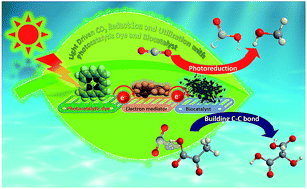当前位置:
X-MOL 学术
›
Sustain. Energy Fuels
›
论文详情
Our official English website, www.x-mol.net, welcomes your feedback! (Note: you will need to create a separate account there.)
Photoredox systems with biocatalysts for CO2 utilization
Sustainable Energy & Fuels ( IF 5.6 ) Pub Date : 2018-06-14 , DOI: 10.1039/c8se00209f Y. Amao 1, 2, 3, 4, 5
Sustainable Energy & Fuels ( IF 5.6 ) Pub Date : 2018-06-14 , DOI: 10.1039/c8se00209f Y. Amao 1, 2, 3, 4, 5
Affiliation

|
Visible-light driven redox systems have been attracting significant research attention due to their ability to produce hydrogen and reduce and utilize CO2 for the production of solar fuels and chemicals. Generally, visible-light driven redox systems consist of an electron donor, a photocatalytic dye, an electron mediator and a catalyst. One of the important components in visible-light driven redox systems is an effective catalyst for hydrogen production and reduction and utilization of CO2. The catalysts used in visible-light driven redox systems are classified into metal nanoparticles, molecular catalysts and biocatalysts. Among them, biocatalysts are promising due to their excellent reaction and substrate selectivity, especially for the reduction and utilization of CO2, which is remarkably higher than that of other catalysts. Among the biocatalysts for CO2 reduction and utilization, NAD(P)+-dependent dehydrogenases, which are commercially available, are widely used in visible-light driven redox systems. Formate dehydrogenase (FDH) from Candida boidinii is a typical NAD(P)+-dependent dehydrogenase for the visible-light driven redox reduction of CO2 to formate. Furthermore, the addition of commercially available aldehyde (aldDH), formaldehyde (FldDH) and alcohol (ADH) dehydrogenase to this system results in the reduction of CO2 to methanol via formate and formaldehyde as intermediates in visible-light driven redox systems. Furthermore, NAD(P)+-dependent dehydrogenases for decarboxylation are also commercially available and widely used for the visible-light driven formation of carbon–carbon bonds from CO2 and organic molecules. Malic enzyme (ME) from chicken liver is a typical NAD(P)+-dependent dehydrogenase with decarboxylating ability for the visible-light driven production of malate, which is based on the formation of carbon–carbon bonds from CO2 and pyruvate. In this review, visible-light driven CO2 reduction and utilization systems involving the photoreduction of NAD(P)+ and biocatalysts are introduced. Furthermore, visible-light driven CO2 reduction and utilization systems involving the photoreduction of bipyridinium salt (viologen)-based electron mediators and biocatalysts also are introduced. In particular, the simplification of visible-light driven CO2 reduction and utilization systems by utilizing viologen-based electron mediators and the improvement in their efficiency without changing the structure of the biocatalyst are also discussed.
中文翻译:

具有生物催化剂的CO 2利用光氧化还原系统
可见光驱动的氧化还原系统由于具有产生氢,还原和利用CO 2来生产太阳能和化学产品的能力而备受关注。通常,可见光驱动的氧化还原系统由电子给体,光催化染料,电子介体和催化剂组成。可见光驱动的氧化还原系统中的重要组成部分之一是有效的制氢,还原和利用CO 2的催化剂。可见光驱动的氧化还原系统中使用的催化剂分为金属纳米颗粒,分子催化剂和生物催化剂。其中,生物催化剂由于其出色的反应和底物选择性,特别是对于减少和利用CO 2,具有广阔的前景。,明显高于其他催化剂。在用于CO 2还原和利用的生物催化剂中,可商购的NAD(P)+依赖性脱氢酶被广泛用于可见光驱动的氧化还原系统中。来自博伊丁氏假丝酵母的甲酸脱氢酶(FDH)是典型的NAD(P)+依赖性脱氢酶,用于可见光驱动的CO 2氧化还原还原成甲酸酯。此外,向该系统中添加市售的醛(aldDH),甲醛(FldDH)和醇(ADH)脱氢酶会导致通过甲醇将CO 2还原为甲醇甲酸盐和甲醛作为可见光驱动的氧化还原系统的中间体。此外,用于脱羧的NAD(P)+依赖性脱氢酶也可商购获得,并广泛用于可见光驱动下由CO 2和有机分子形成碳-碳键。鸡肝中的苹果酸酶(ME)是一种典型的NAD(P)+依赖性脱氢酶,具有可见光驱动的苹果酸脱羧能力,其基于CO 2和丙酮酸形成的碳-碳键。在这篇综述中,可见光驱动的CO 2还原和利用系统涉及NAD(P)+的光还原并介绍了生物催化剂。此外,还引入了可见光驱动的CO 2还原和利用系统,该系统涉及基于联吡啶鎓盐(紫精)的电子介体和生物催化剂的光还原。特别地,还讨论了通过利用基于紫精的电子介体来简化可见光驱动的CO 2还原和利用系统,以及在不改变生物催化剂的结构的情况下提高其效率。
更新日期:2018-08-22
中文翻译:

具有生物催化剂的CO 2利用光氧化还原系统
可见光驱动的氧化还原系统由于具有产生氢,还原和利用CO 2来生产太阳能和化学产品的能力而备受关注。通常,可见光驱动的氧化还原系统由电子给体,光催化染料,电子介体和催化剂组成。可见光驱动的氧化还原系统中的重要组成部分之一是有效的制氢,还原和利用CO 2的催化剂。可见光驱动的氧化还原系统中使用的催化剂分为金属纳米颗粒,分子催化剂和生物催化剂。其中,生物催化剂由于其出色的反应和底物选择性,特别是对于减少和利用CO 2,具有广阔的前景。,明显高于其他催化剂。在用于CO 2还原和利用的生物催化剂中,可商购的NAD(P)+依赖性脱氢酶被广泛用于可见光驱动的氧化还原系统中。来自博伊丁氏假丝酵母的甲酸脱氢酶(FDH)是典型的NAD(P)+依赖性脱氢酶,用于可见光驱动的CO 2氧化还原还原成甲酸酯。此外,向该系统中添加市售的醛(aldDH),甲醛(FldDH)和醇(ADH)脱氢酶会导致通过甲醇将CO 2还原为甲醇甲酸盐和甲醛作为可见光驱动的氧化还原系统的中间体。此外,用于脱羧的NAD(P)+依赖性脱氢酶也可商购获得,并广泛用于可见光驱动下由CO 2和有机分子形成碳-碳键。鸡肝中的苹果酸酶(ME)是一种典型的NAD(P)+依赖性脱氢酶,具有可见光驱动的苹果酸脱羧能力,其基于CO 2和丙酮酸形成的碳-碳键。在这篇综述中,可见光驱动的CO 2还原和利用系统涉及NAD(P)+的光还原并介绍了生物催化剂。此外,还引入了可见光驱动的CO 2还原和利用系统,该系统涉及基于联吡啶鎓盐(紫精)的电子介体和生物催化剂的光还原。特别地,还讨论了通过利用基于紫精的电子介体来简化可见光驱动的CO 2还原和利用系统,以及在不改变生物催化剂的结构的情况下提高其效率。


























 京公网安备 11010802027423号
京公网安备 11010802027423号